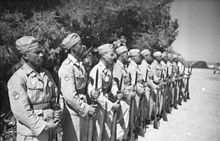Special Association 287
The Sonderverband 287 was a fully motorized unit of the Wehrmacht , set up for use in Arab countries.
Lineup
On June 21, 1941, the Wehrmacht High Command ordered that the special staff F , responsible “for all questions in the Arab world that concern the Wehrmacht”, had to set up a “special unit F”, a “motorized battalion with plenty of auxiliary weapons”. But it wasn't until the summer of 1942 that the association began to be established.
The staff of special unit 287 was formed from special staff F. Sonderstab F was the code name for the German military mission of General der Flieger Hellmuth Felmy , who in May 1941 led an air force association in Iraq to support the uprising there against British rule. On August 4, 1942, the special staff F was formed into a regimental staff for the unit now called Sonderverband 287, and the troops were set up in Potsdam in the ruins of the mountain barracks. Soldiers in particular who were familiar with the Arab world were assigned to special unit 287, and specialists with desert experience, such as former Foreign Legionnaires .
The special unit 287, like the special unit 288 , was intended for the conquest of the oil wells in the Near and Middle East . In October 1942, the Special Unit 287, in addition to its already existing Panzergrenadier battalion , was reinforced by two more Panzer Grenadier battalions. The troop body, which had now reached regimental strength, had all the weapons and support units in order to be able to operate completely independently.
commitment
The Sonderverband 287 was without its III. Battalion, which went to Africa, moved to the Ukraine in September 1942 and from there took part in the German advance into the Caucasus . The special unit was then to penetrate further south in order to march from there through Iran to Iraq , where it was to unite with the Africa Corps , which was to fight its way from Egypt to Asia . When the German advance in the Caucasus towards Iran stalled, Sonderverband 287 was used to secure the Kalmyk steppe . At the beginning of 1943, with the withdrawal of German troops from the Caucasus region, the unit's fighting to withdraw from the Kalmyk steppe back to Ukraine began.
With the surrender of Panzer Group Africa in Tunisia in May 1943, the III. Battalion of the special association 287 in captivity. It had served as southern flank protection for the German troops in North Africa and had been used for special operations in the rear of the enemy. The German-Arab Infantry Battalion 845, which was deployed in the Balkans, was formed from members of the battalion who had fled.
On May 2, 1943, the remaining parts of Sonderverband 287 were renamed Grenadier Regiment 92 (motorized) and relocated to Yugoslavia to fight partisans. The partisan war in Yugoslavia dragged on in 1944 until the regiment suffered heavy losses in heavy fighting near Belgrade in October 1944 and as a result was rebuilt into the 92nd Panzer Grenadier Brigade in January 1945. From February 1945 the brigade was engaged in heavy fighting in western Hungary against the Red Army . In April 1945, fighting began to withdraw to Austria, where the association saw the end of the war in May 1945.
See also
Individual evidence
- ^ Walther Hubatsch: Hitler's instructions for warfare 1939-1945. Deutscher Taschenbuch Verlag, Munich 1965, pages 157–158.
- ↑ Roland Kaltenegger : The German Mountain Troop 1935-1945. Weltbild Verlag, Augsburg 2000, ISBN 3-8289-0351-7 . Pages 230 and 527-528.
- ↑ Roland Kaltenegger: The German Mountain Troop 1935-1945. Weltbild Verlag, Augsburg 2000, ISBN 3-8289-0351-7 . Page 528.
- ^ Rolf Stoves: The armored and motorized large German associations. Podzun-Pallas-Verlag, Friedberg 1986. ISBN 3-7909-0279-9 . Pages 288-289.
